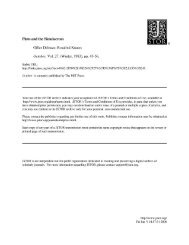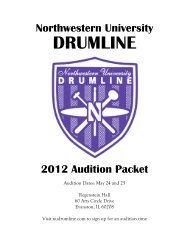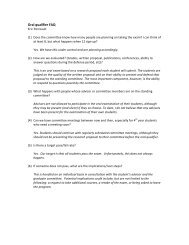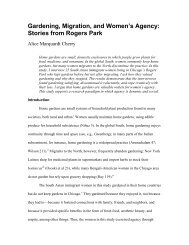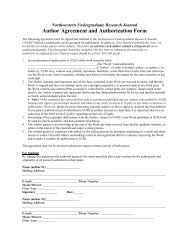research - Associated Student Government, Northwestern University
research - Associated Student Government, Northwestern University
research - Associated Student Government, Northwestern University
Create successful ePaper yourself
Turn your PDF publications into a flip-book with our unique Google optimized e-Paper software.
RESEARCHcarriers, the company’s rapid expansion in the last decade has brought it into more markets in which the legacy carriershave large operations, such as Philadelphia (US Airways), Denver (United), Washington Dulles (United), andMinneapolis/St. Paul (Delta, previously Northwest). In addition, Chicago Midway is currently Southwest’s busiestairport in terms of airport departures, adding significant competition to American and United Airlines’ hub operationsat Chicago O’Hare. With Southwest’s increasing presence in markets traditionally dominated by the legacycarriers, this study explores the notion that the legacy carriers have experienced a decline in their hub premiums andSouthwest’s expansion into the hubbing carriers’ hub markets is the driving force behind this decline.Southwest’s operations at some airports have become so large that these airports could effectively be consideredhubs for Southwest. Thus, this <strong>research</strong> also attempts to look into the plausibility that Southwest commands hubpremiums of its own.Southwest, by operating at hubs of the legacy carriers, can follow the hubbing airlines by charging higher pricesinstead of imposing price-decreasing competition on flights with an endpoint at these hub airports. To explore thepossibility that Southwest may benefit from such an umbrella effect (Borenstein, 1989), this study further examinesthe nature of competition between Southwest Airlines and the legacy carriers within the hub networks of these carriers.In short, this <strong>research</strong>, in studying the pricing practices of Southwest, intends to address if a Southwest effectexits, if Southwest commands hub premiums of its own, and if Southwest benefits from hub operations of the legacycarriers.II. Data and methodologyDataThe original source of the data is the U.S. Department of Transportation’s Domestic Origin and Destination Survey,Databank 1B (OD1B), which represents a 10 percent sample of airline tickets from reporting carriers. Data usedin this study are for the second quarters of 2000 and 2010 of the HUBSup Low Level O&D Data provided by DataBase Products, Inc. The same quarters of each year are used in order to avoid seasonality effects.MethodologyThis paper employs a model similar to that used by Lee and Luengo-Prado (2005) and defines the hub premiumas the ability of an airline to charge higher fares for flights to or from a hub than for similar flights in its own networkthat do not originate or end at a hub airport. The natural log of price, lnprice, is regressed on key variables and a setof controls. The key variables are as follows:• Share: variable with values between zero and one, capturing the carrier’s market share of O&D passengers measuredas the total passengers on a route served by a given carrier divided by the total number of passengers flyingon the same route served by all carriers.• Lowcost2: dummy variable equal to one if low-cost carriers, excluding Southwest (JetBlue, Frontier, Tower,AirTran, Midway, Legend, National, Vanguard, Spirit, ProAir, ATA, Access Air, and Sun Country), have greaterthan a 1% share of O&D passengers in a market, zero otherwise.• Hub: A dummy variable with a value one if the origin or destination was a hub for the marketing carrier, zerootherwise. For Southwest, the hubs are identified as the top 10 airports based on percentage of passengers whoare making a connection.• WN (Southwest’s carrier code): A dummy variable with a value of one if the origin or destination airport was atop 20 Southwest airport or near a top 20 Southwest airport, as determined by the number of flights departingfrom an airport.• AA, CO, DL, NW, UA, and US: dummy variables for each legacy carrier that take on the value of one if the originor destination of the route is at or near a hub of the given legacy carrier, zero otherwise.Southwest Effect ModelIn an effort to recognize the possibility that any significant changes in the hub premiums of the legacy carriersfrom 2000 to 2010 may be attributed to the operations of Southwest, models used by Lee and Luengo-Prado (2005)are modified into Equation (1).lnprice=α+β1hub+β2WN+β3lowcost2+β4share+βicontrolsi+βjslotsj+ε 1where controls iis the set of control variables (lnmiles, lnmktpax, and owprop) and slots jis the set of dummies for theslot-restricted airports. The intent of the lowcost2 and WN dummies is to capture a Southwest effect without incurringthe risk of mistaking a general effect of lowcost carriers as a Southwest effect.34 NORTHWESTERN UNDERGRADUATE RESEARCH JOURNAL




